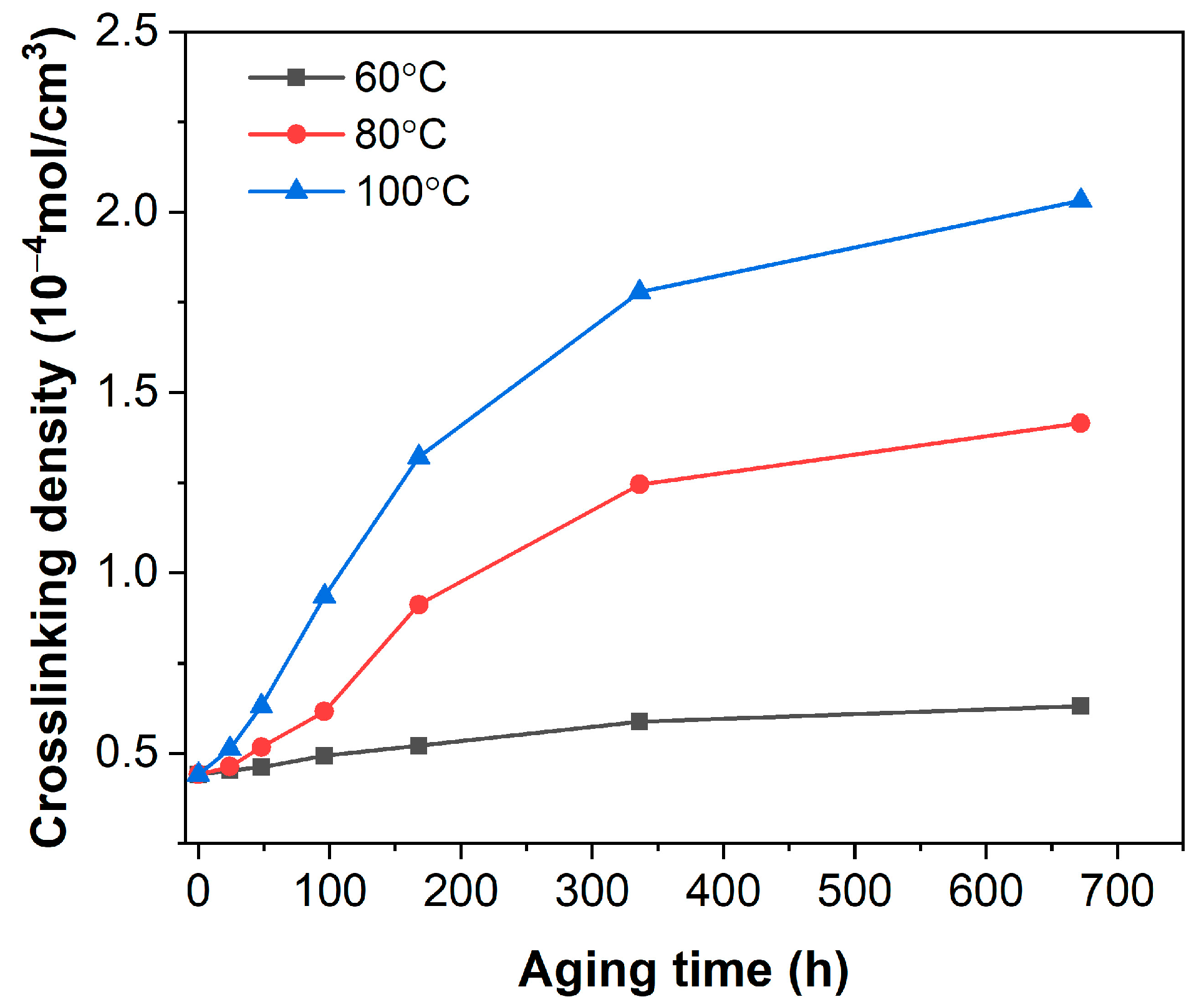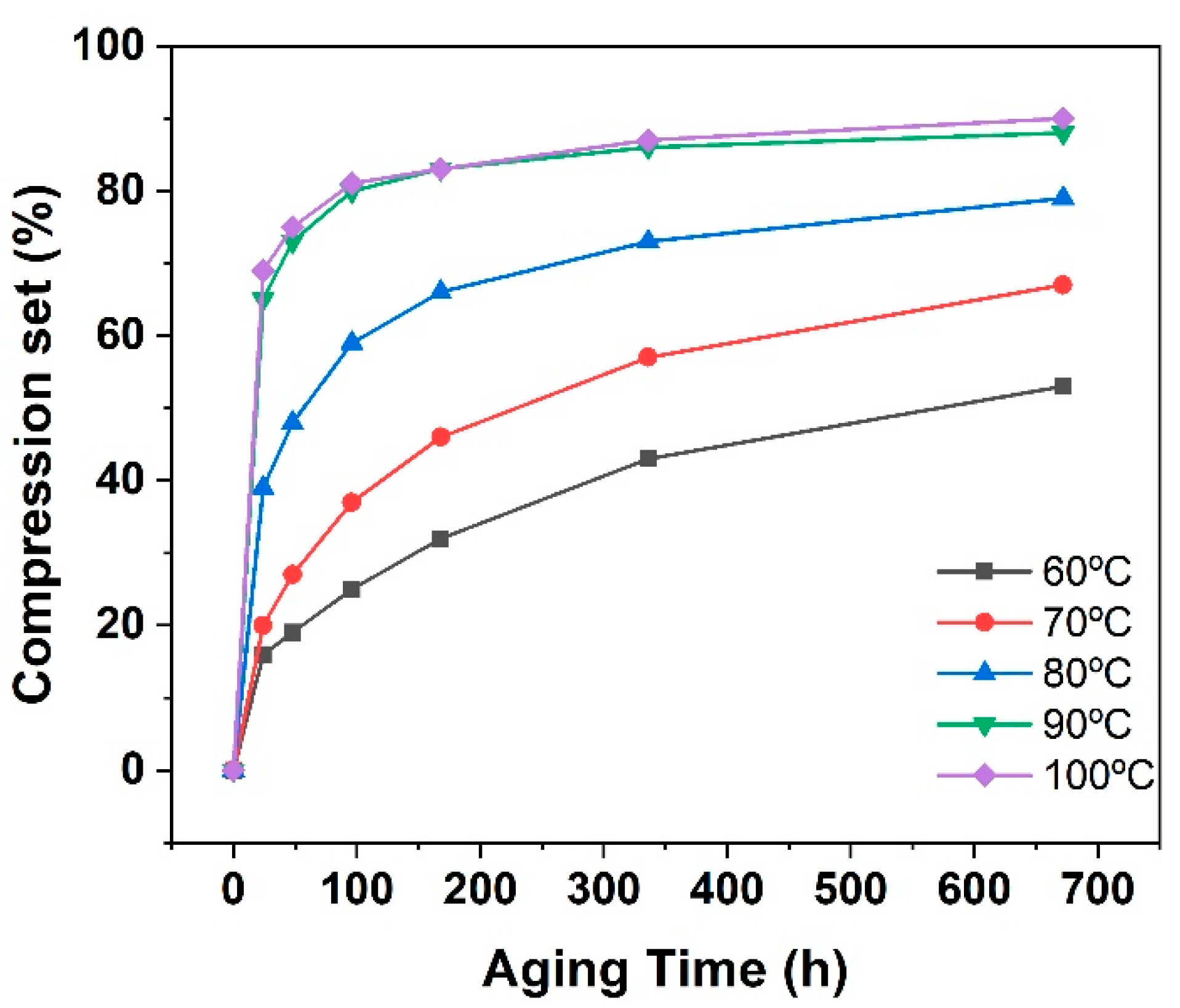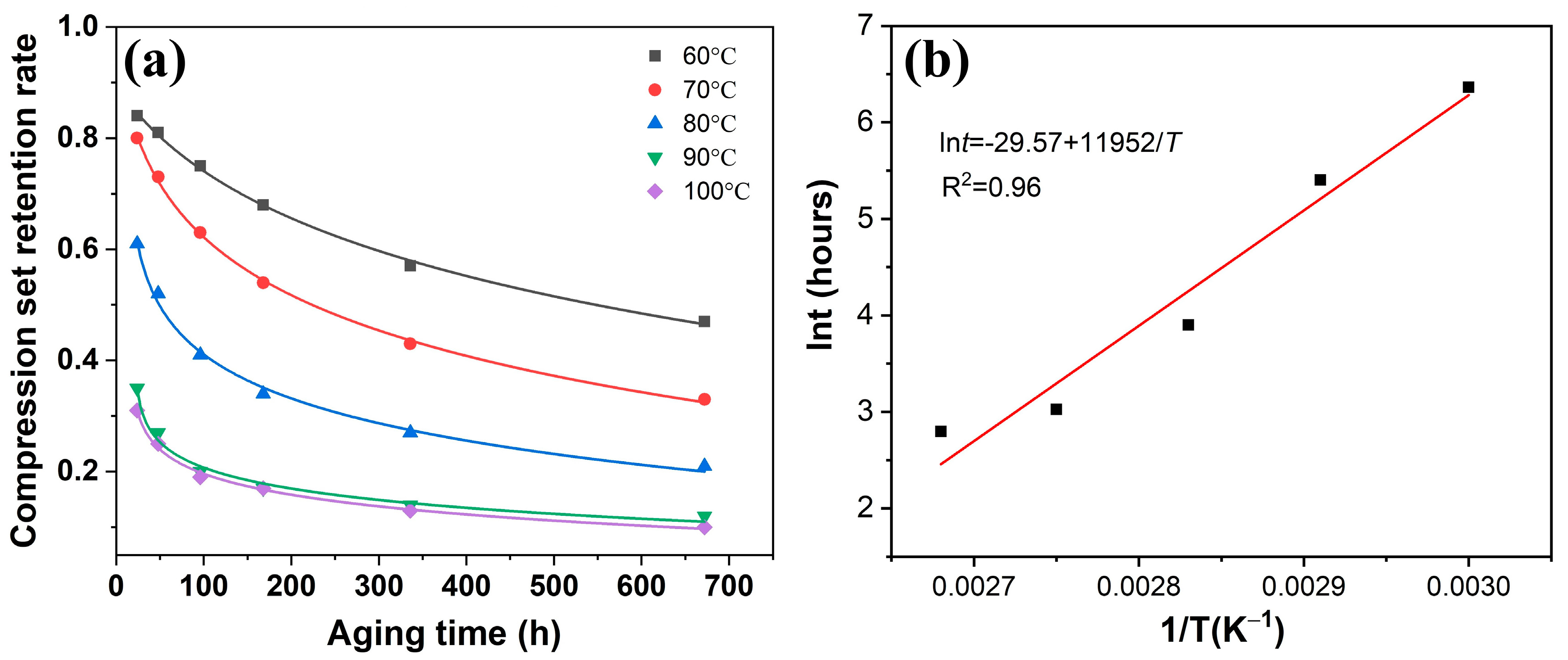Thermal Oxidative Aging and Service Life Prediction of Commercial Ethylene–Propylene–Diene Monomer Spacer Damping Composites for High–Voltage Transmission Lines
Abstract
:1. Introduction
2. Experimental Materials and Methods
2.1. Materials
2.2. Methods
2.2.1. Preparation of EPDM Specimens
2.2.2. Characterization
3. Results and Discussion
3.1. Chemical Structure of EPDM Composites
3.2. Thermogravimetry Analysis of EPDM Composites
3.3. Microstructure of EPDM Composites
3.4. Mechanical Properties of EPDM Composites
3.5. Crosslinking Density of EPDM Composites
3.6. Compression Set of EPDM Composites
3.7. Dynamic Damping of Rubber Composites
3.8. Service Life Prediction
4. Conclusions
Author Contributions
Funding
Institutional Review Board Statement
Data Availability Statement
Conflicts of Interest
References
- Yang, Z.; Guo, B.; Zhang, L. Challenge of rubber/graphene composites aiming at real applications. Rubber Chem. Technol. 2017, 90, 225–237. [Google Scholar] [CrossRef]
- Lenko, D.; Schlögl, S.; Bichler, S.; Lemesch, G.; Ramsauer, F.; Ladstätter, W.; Kern, W. Flexible epoxy-silicone rubber laminates for high voltage insulations with enhanced delamination resistance. Polym. Compos. 2015, 36, 2238–2247. [Google Scholar] [CrossRef]
- Zhao, Z.; Liu, B.; Liu, S.; Zhang, D. Design and Test of Quad-Bundle Spacer Damper Based on a New Rubber Structure. Shock Vib. 2023, 2023, 3828501. [Google Scholar] [CrossRef]
- Johnson, B.L.; Cameron, F.K. Mechanism of rubber aging. Ind. Eng. Chem. 1933, 25, 1151–1152. [Google Scholar] [CrossRef]
- Li, G.-Y.; Koenig, J.L. A Review of Rubber Oxidation. Rubber Chem. Technol. 2005, 78, 355–390. [Google Scholar] [CrossRef]
- Deuri, A.S.; Bhowmick, A.K. Aging of EPDM rubber. J. Appl. Polym. Sci. 1987, 34, 2205–2222. [Google Scholar] [CrossRef]
- Andrews, R.D.; Tobolsky, A.V.; Hanson, E.E. The theory of permanent set at elevated temperatures in natural and synthetic rubber vulcanizates. J. Appl. Phys. 1946, 17, 352–361. [Google Scholar] [CrossRef]
- Tobolsky, A.V.; Prettyman, I.B.; Dillon, J.H. Stress relaxation of natural and synthetic rubber stocks. Rubber Chem. Technol. 1944, 17, 551–575. [Google Scholar] [CrossRef]
- Dunn, J.R.; Scanlan, J.; Watson, W.F. Stress relaxation during the thermal oxidation of vulcanized natural rubber. Trans. Faraday Soc. 1959, 55, 667–675. [Google Scholar] [CrossRef]
- Bartenev, G.M.; Lyalina, N.M. Stress relaxation mechanisms in rubbers reinforced with carbon blacks. Rubber Chem. Technol. 1972, 45, 82–93. [Google Scholar] [CrossRef]
- Beatty, J.R.; Juve, A.E. Stress relaxation of some rubber and synthetic rubber vulcanizates in compression. Rubber Chem. Technol. 1950, 23, 786–802. [Google Scholar] [CrossRef]
- Ronan, S. A Novel Approach to Predicting the Lifetime of Elastomers Undergoing Stress Relaxation. Ph.D. Thesis, Dublin Institute of Technology, Dublin, Ireland, September 2009. [Google Scholar]
- Hu, Q.; Chen, Q.; Song, P.; Gong, X.; Chen, J.; Zhao, Y. Performance of Thermal-Oxidative Aging on the Structure and Properties of Ethylene Propylene Diene Monomer (EPDM) Vulcanizates. Polymers 2023, 15, 2329. [Google Scholar] [CrossRef] [PubMed]
- Delor-Jestin, F.; Lacoste, J.; Barrois-Oudin, N.; Cardinet, C.; Lemaire, J. Photo-, thermal and natural ageing of ethylene–propylene–diene monomer (EPDM) rubber used in automotive applications. Influence of carbon black, crosslinking and stabilizing agents. Polym. Degrad. Stab. 2000, 67, 469–477. [Google Scholar] [CrossRef]
- Kwak, S.B.; Choi, N.S. Thermo-oxidative degradation of a carbon black compounded EPDM rubber hose. Int. J. Automot. Technol. 2011, 12, 401–408. [Google Scholar] [CrossRef]
- Ning, N.; Ma, Q.; Zhang, Y.; Zhang, L.; Wu, H.; Tian, M. Enhanced thermo-oxidative aging resistance of EPDM at high temperature by using synergistic antioxidants. Polym. Degrad. Stab. 2014, 102, 1–8. [Google Scholar] [CrossRef]
- Tu, J.; Shi, X.; Jing, Y.; Zou, H.; Kadlcak, J.; Yong, Z.; Liu, S.; Liu, G. Relationships of tensile strength with crosslink density for the high-carbon black-filled EPDM compounds with various softeners. Polym. Eng. Sci. 2021, 61, 2213–2221. [Google Scholar] [CrossRef]
- Paul, J.; John, R. Statistical mechanics of cross-linked polymer networks. I. Rubberlike elasticity. J. Chem. Phys. 1943, 11, 512–517. [Google Scholar]
- Baranwal, K.C.; Lindsay, G.A. Diene Termonomer Type and EPDM Properties. Rubber Chem. Technol. 1972, 45, 1334–1347. [Google Scholar] [CrossRef]
- ISO 48-4:2018; Rubber, Vulcanized or Thermoplastic Determination of Hardness Part 4: Indentation Hardness by Durometer Method (Shore Hardness). International Organization for Standardization: Geneva, Switzerland, 2018.
- ISO 37:2017; Rubber, Vulcanized or Thermoplastic—Determination of Tensile Stress-Strain Properties. International Organization for Standardization: Geneva, Switzerland, 2017.
- ISO 815-1:2019; Rubber, vulcanized or thermoplastic—Determination of compression set—Part 1: At ambient or elevated temperatures. International Organization for Standardization: Geneva, Switzerland, 2019.
- ISO 188:2023; Rubber, Vulcanized or Thermoplastic Accelerated Ageing and Heat Resistance Tests. International Organization for Standardization: Geneva, Switzerland, 2023.
- Alexander, M.; Thachil, E.T. A comparative study of cardanol and aromatic oil as plasticizers for carbon-black-filled natural rubber. J. Appl. Polym. Sci. 2006, 102, 4835–4841. [Google Scholar] [CrossRef]
- Zhao, Q.; Li, X.; Gao, J. Surface degradation of ethylene–propylene–diene monomer (EPDM) containing 5-ethylidene-2-norbornene (ENB) as diene in artificial weathering environment. Polym. Degrad. Stab. 2008, 93, 692–699. [Google Scholar] [CrossRef]
- Zhao, Q.; Li, X.; Gao, J. Aging of ethylene–propylene–diene monomer (EPDM) in artificial weathering environment. Polym. Degrad. Stab. 2007, 92, 1841–1846. [Google Scholar] [CrossRef]
- Li, C.; Wang, Y.; Yuan, Z.; Ye, L. Construction of sacrificial bonds and hybrid networks in EPDM rubber towards mechanical performance enhancement. Appl. Surf. Sci. 2019, 484, 616–627. [Google Scholar] [CrossRef]
- Gunasekaran, S.; Natarajan, R.; Kala, A. FTIR spectra and mechanical strength analysis of some selected rubber derivatives. Spectrochim. Acta Part A 2007, 68, 323–330. [Google Scholar] [CrossRef]
- Li, C.; Ding, Y.; Yang, Z.; Yuan, Z.; Ye, L. Compressive stress-thermo oxidative ageing behaviour and mechanism of EPDM rubber gaskets for sealing resilience assessment. Polym. Test. 2020, 84, 106366. [Google Scholar] [CrossRef]
- Gamlin, C.; Markovic, M.G.; Dutta, N.K.; Choudhury, N.R.; Matisons, J.G. Structural Effects on the Decomposition Kinetics of EPDM Elastomers by High-Resolution TGA and Modulated TGA. J. Therm. Anal. Calorim. 2000, 59, 319–336. [Google Scholar] [CrossRef]
- Tomer, N.S.; Delor-Jestin, F.; Singh, R.P.; Lacoste, J. Cross-linking assessment after accelerated ageing of ethylene propylene diene monomer rubber. Polym. Degrad. Stab. 2007, 92, 457–463. [Google Scholar] [CrossRef]
- Liu, J.; Wang, B.; Zhang, L.W.; Zhu, L.; Luo, T.Y. Thermal aging behavior of ethylene propylene diene monomer (EPDM) rubber. Appl. Mech. Mater. 2015, 727, 47–50. [Google Scholar] [CrossRef]
- Longkaew, K.; Gibaud, A.; Tessanan, W.; Daniel, P.; Phinyocheep, P. Spherical CaCO3: Synthesis, Characterization, Surface Modification and Efficacy as a Reinforcing Filler in Natural Rubber Composites. Polymers 2023, 15, 4287. [Google Scholar] [CrossRef]
- Liu, J.; Li, X.; Xu, L.; Zhang, P. Investigation of aging behavior and mechanism of nitrile-butadiene rubber (NBR) in the accelerated thermal aging environment. Polym. Test. 2016, 54, 59–66. [Google Scholar] [CrossRef]
- Sarkar, P.; Bhowmick, A.K. Sustainable rubbers and rubber additives. Polymer 2018, 135, 45701. [Google Scholar] [CrossRef]
- Hakkarainen, M.; Albertsson, A.-C.; Karlsson, S. Migration and emission of plasticizer and its degradation products during thermal aging of nitrile rubber. Int. J. Polym. Anal. 2003, 8, 279–293. [Google Scholar] [CrossRef]
- Chen, S.; Li, T.; Wan, S.; Huang, X.; Cai, S.; He, X.; Zhang, R. Effect of Nitrogen-Doped Graphene Oxide on the Aging Behavior of Nitrile–Butadiene Rubber. Polymers 2019, 11, 1637. [Google Scholar] [CrossRef] [PubMed]
- Zhang, X.; Li, J.; Chen, Z.; Pang, C.; He, S.; Lin, J. Study on Thermal-Oxidative Aging Properties of Ethylene-Propylene-Diene Monomer Composites Filled with Silica and Carbon Nanotubes. Polymers 2022, 14, 1205. [Google Scholar] [CrossRef] [PubMed]
- Abdel-Aziz, M.M.; Basfar, A.A. Aging of ethylene-propylene diene rubber (EPDM) vulcanized by γ-radiation. Polym. Test. 2000, 19, 591–602. [Google Scholar] [CrossRef]
- Lou, W.; Zhang, W.; Liu, X.; Dai, W.; Xu, D. Degradation of hydrogenated nitrile rubber (HNBR) O-rings exposed to simulated servo system conditions. Polym. Degrad. Stab. 2017, 144, 464–472. [Google Scholar] [CrossRef]
- Hu, X.; Zhang, R.; Wemyss, A.M.; Du, A.; Bao, X.; Geng, X.; Wan, C. Damping and Electromechanical Behavior of Ionic-Modified Brominated Poly(isobutylene-co-isoprene) Rubber Containing Petroleum Resin C5. Ind. Eng. Chem. Res. 2022, 61, 3063–3074. [Google Scholar] [CrossRef]
- Bala, A.; Gupta, S. Thermal resistivity, sound absorption and vibration damping of concrete composite doped with waste tire Rubber: A review. Constr. Build. Mater. 2021, 299, 123939. [Google Scholar] [CrossRef]
- Wang, X.; Chen, X.; Song, M.; Wang, Q.; Zheng, W.; Song, H.; Fan, Z.; Myat Thu, A. Effects of Hindered Phenol Organic Molecules on Enhancing Thermo-Oxidative Resistance and Damping Capacity for Nitrile Butadiene Rubber: Insights from Experiments and Molecular Simulation. Ind. Eng. Chem. Res. 2020, 59, 11494–11504. [Google Scholar] [CrossRef]
- Evgin, T.; Mičušík, M.; Machata, P.; Peidayesh, H.; Preťo, J.; Omastová, M. Morphological, Mechanical and Gas Penetration Properties of Elastomer Composites with Hybrid Fillers. Polymers 2022, 14, 4043. [Google Scholar] [CrossRef] [PubMed]
- Xu, Z.; Jerrams, S.; Zheng, L.; Zhang, L.; Liu, L.; Wen, S. Green Fabrication of High-Performance, Lignosulfonate-Functionalized, and Reduced-Graphene Oxide Styrene–Butadiene Rubber Composites. Ind. Eng. Chem. Res. 2021, 60, 17989–17998. [Google Scholar] [CrossRef]
- Xiang, K.-L.; Xiang, P.-Y.; Wu, Y.-P. Prediction of the fatigue life of natural rubber composites by artificial neural network approaches. Mater. Des. 2014, 57, 180–185. [Google Scholar] [CrossRef]
- Woo, C.S.; Park, H.S. Useful lifetime prediction of rubber component. Eng. Fail. Anal. 2011, 18, 1645–1651. [Google Scholar] [CrossRef]
- Guo, X.; Yuan, X.; Liu, G.; Hou, G.; Zhang, Z. Storage Life Prediction of Rubber Products Based on Step Stress Accelerated Aging and Intelligent Algorithm. Polymers 2023, 15, 157. [Google Scholar] [CrossRef] [PubMed]
- Vakulov, N.V.; Myshlyavtsev, A.V.; Malyutin, V.I. Estimation of in-use Guaranteed Rubber Lifetime test methods. Procedia Eng. 2015, 113, 479–483. [Google Scholar] [CrossRef]








| Chemicals | Contents (Per Hundred Parts of Rubbers, Phr) |
|---|---|
| EPDM | 100 |
| Zinc oxide | 5 |
| Stearic acid | 3 |
| Antioxidant 4010NA | 3 |
| Antioxidant RD | 2 |
| Carbon black (N550) | 145 |
| Calcium carbonate | 115 |
| Paraffin oil | 80 |
| Accelerator BZ | 1 |
| Accelerator TMTD 1.5 | 1.5 |
| Accelerator M | 1 |
| Sulfur | 1.5 |
Disclaimer/Publisher’s Note: The statements, opinions and data contained in all publications are solely those of the individual author(s) and contributor(s) and not of MDPI and/or the editor(s). MDPI and/or the editor(s) disclaim responsibility for any injury to people or property resulting from any ideas, methods, instructions or products referred to in the content. |
© 2024 by the authors. Licensee MDPI, Basel, Switzerland. This article is an open access article distributed under the terms and conditions of the Creative Commons Attribution (CC BY) license (https://creativecommons.org/licenses/by/4.0/).
Share and Cite
Zhou, Y.; Qiu, L.; Xu, Z.; Huang, S.; Nie, J.; Yin, H.; Tu, F.; Zhao, Z. Thermal Oxidative Aging and Service Life Prediction of Commercial Ethylene–Propylene–Diene Monomer Spacer Damping Composites for High–Voltage Transmission Lines. Polymers 2024, 16, 1186. https://doi.org/10.3390/polym16091186
Zhou Y, Qiu L, Xu Z, Huang S, Nie J, Yin H, Tu F, Zhao Z. Thermal Oxidative Aging and Service Life Prediction of Commercial Ethylene–Propylene–Diene Monomer Spacer Damping Composites for High–Voltage Transmission Lines. Polymers. 2024; 16(9):1186. https://doi.org/10.3390/polym16091186
Chicago/Turabian StyleZhou, Yutong, Lvchao Qiu, Zongchao Xu, Shixuan Huang, Jingkai Nie, Hang Yin, Feng Tu, and Zhoufeng Zhao. 2024. "Thermal Oxidative Aging and Service Life Prediction of Commercial Ethylene–Propylene–Diene Monomer Spacer Damping Composites for High–Voltage Transmission Lines" Polymers 16, no. 9: 1186. https://doi.org/10.3390/polym16091186





